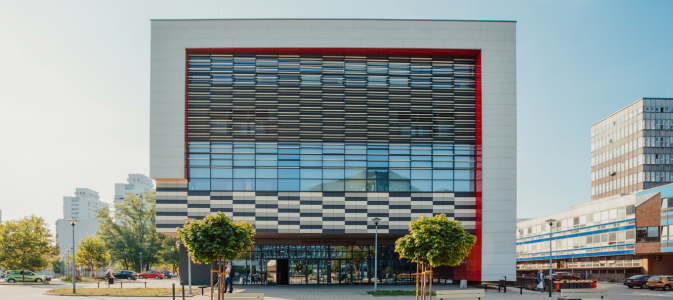
Szanowni Państwo,
Wydział Biotechnologii zaprasza na cykl 5 wykładów – Classical articles that founded molecular genetics – które wygłosi Profesor Honorowy Wydziału Lekarskiego Uniwersytetu Genewskiego, Dominique Belin, odwiedzający Uniwersytet Wrocławski w ramach Programu zapraszania profesorów wizytujących, realizowanego ze środków IDUB.
Wykłady – otwarte dla wszystkich zainteresowanych osób – będą odbywać się w budynku Wydziału Biotechnologii, przy ul. F. Joliot-Curie 14a w sali 1.05, w dniach od 4 do 11 czerwca 2024 r. w godzinach 14.30-16.30.

Zapraszamy do zapoznania się ze szczegółowym harmonogramem wizyty oraz notą biograficzną Profesora:
1. Wtorek, 4 czerwca, g. 14.30, aula 1.05:
Genes and the origin of mutations
Genes were abstract entities for Mendel and Morgan. The first evidence that genes control enzymes was obtained by Garrod who observed that a rare disorder of amino acid catabolism is only observed in predisposed families. The work of Beadle and Tatum on nutritional mutants in microbes showed that mutants could be isolated in any gene coding for a metabolic enzyme.
The origin of mutations was hotly debated between followers of Lamarck or Darwin. In bacteria, the question was settled by the fluctuation test of Luria and Delbrück. However, recent experiments also support a Lamarckian mechanism of inheritance.
2. Środa, 5 czerwca, g. 14.30, aula 1.05
DNA as the genetic material & the double helix
Everybody knows that genes are made of DNA. However, the original discovery of Avery was hotly disputed and its main criticism, a protein contaminant in Avery’s DNA, will be discussed. The issue was settled by the experiment of Hershey and Chase who used bacterial viruses containing radioactive DNA or proteins. Radioactive DNA was found inside cells and in phage progeny, The double helix structure proposed by Watson and Crick is one of the most important events in biology. This will be placed in the context of the crystallographic data of the time (Wilkins and Franklin).
3. Piątek, 07 czerwca, g. 14.30, aula 1.05
Genetic fine structure & the genetic code: The rII system of phage T4
The rII mutants of phage T4 provided a fantastic system to probe the structure of the gene. rII mutants can be easily isolated by looking at lytic plaques on a bacterial lawn. What is unique about rII mutants is that one can isolate very rare recombinants or revertants that a wild type behaviour. This allowed Benzer to show that the topography of the gene is linear, in agreement with the double helix model, and then that the different parts of the gene have very different propensity to mutate, which was not predicted by the double helix model. Crick exploited this system to propose that the genetic code, which defines the relationship between DNA and proteins consists of groups of 3 nucleotides, the triplets or codons.
4. Wtorek, 11 czerwca, g. 14.30, aula 1.05
Nonsense mutations and developmental genetics
Conditional lethal mutations, temperature-sensitive or nonsense, are essential to study essential genes. Nonsense mutations interrupt the translation of mRNA. An unsuspected property of E. coli K-12 resulted in the occurrence of strains that recognize one or more nonsense codons. Thus, a nonsense mutant can grow in a suppressor strain and the effect of the absence of the protein can be studied in a non-suppressor strain. Brenner deduced the sequence of two nonsense codons, UAG and UAA, by a combination of genetic and biochemical studies. Using nonsense and temperature-sensitive mutations, Epstein and Edgar identified all the essential genes of phage T4. This allowed Wood to decipher the assembly pathway that allow phage heads, tails, and tail fibers to form an infectious virus.
5. Środa, 12 czerwca, g. 14.30, aula 1.05
Regulation of gene expression
The differential expression of genes in microorganisms fed with different sugars was first called adaptation. Lactose is one of these sugars and growth on lactose requires two enzymes, a permease and a hydrolase. Both are only found in cells when lactose is present, this is the inducible phenotype. Constitutive mutants always express the two genes. Jacob, Monod and Pardee observed that when a wild type lactose DNA is introduced into a bacterium unable to use lactose, the cells are first constitutive and later become inducible. This led to the operon model: in addition to structural genes, there are regulatory genes and sites on the DNA where the regulators bind and prevent expression. Later work by Engelsberg on the arabinose system showed that there are also positive regulators that activate expression.
Dominique Belin
Professeur honoraire, Faculté de médecine, Université de Genève
Professor D. Belin obtained a PhD in molecular biology in Geneva and was a post-doctoral fellow at Rockefeller University (New York). He worked in the Pathology Department of the University of Geneva from 1982 to 2017 and is now Professor emeritus im the Faculty of Medicine. He spent one year in the Microbiology Department at Harvard Medical School as a visiting professor.
After studying an unusual temperature-sensitive mutant of phage T4, he cloned the murine uPA gene, an actor of extracellular proteolysis. PAI-2, a uPA inhibitor, partitions between the cytoplasm and the extracellular space. This led to studies on protein export, both biochemically and genetically, in E. coli. Recently, he studied genes of unknown function in the phage T4 genome. These genes represent the dark matter of the biological universe.

fot. Magdalena Marcula









